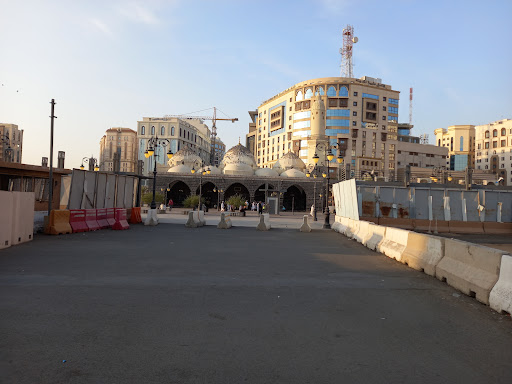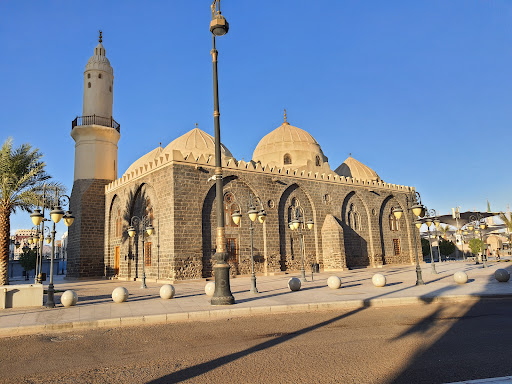Mosque of al-Ghamamah (مسجد الغمامة) is one of the oldest mosques in Medina, Saudi Arabia, located in the place believed to be where the prophet Muhammad performed an Eid prayer in the year 631 CE. According to the Hadith tradition , once the people of Medina complained to prophet Muhammad on the lack of water and rain fall and their hardships in consequence. At the moment prophet was at the Masjid e Nabavi, he rose and emerged from the mosque and offered "Salat ul-Istisqaa" at this approximate location. As he prayed the clouds started to gather and rain fell.
The facade and the main entrance to the mosque. The word "Ghamama" means cloud in arabic. It is situated near abi Bakr Mosque. Initially a small mosque was built here by first caliph Umer ibn Khattab it was was later renovated by Sultan Abdul Majeed Al Uthmani and recently by King Fahad bin Abdul Azeez Al Saud. This Masjid is in right front corner of Masjid al-Nabawi some 300 meters away from current gate to courtyard of the Masjid.
The mosque was built during the reign of the Caliph Umar bin Abdul Aziz between the hijri calendar of 86 to 93, and renovated by the Sultan Hasan bin Muhammad bin Qalawan Ash-Shalihi in 1340 during the Sharifate of Mecca era. It was renovated again by the Sharif Saifuddin Inal Al-Ala'i in 1622, and the time of the Sultan Abd-ul-Mejid I in 1859 during the Ottoman era, using new tools and the look resembled more or less the shape of today.
mosque is rectangular shaped, and made of two parts, which are entrance door and prayer room. The entrance door is also rectangular shaped and has a length of 26 meters and width of 4 meters, and has five dome-shaped circles drawn on facade. Prayer room has a length of 30 meters and width of 15 meters. It is located at 500 meters west of as-Salam door of al-Masjid an-Nabawi.
It is also narrated that Prophet Muhammad offered Salat ul-Istasqa when the city of Madina faced a shortage of rain. For a while, this mosque was closed for daily prayers because of its proximity to the Al-Masjid an-Nabawi. However quite recently it has been reopened for the worshipers for praying. Five times prayers are held in this mosque now with an internal sound system to avoid the clash of sounds from the Prophet's Mosque. The mosque is one of the historical mosques of Medina.
It is also narrated that Prophet Muhammad offered Salat ul-Istasqa when the city of Madina faced a shortage of rain. For a while, this mosque was closed for daily prayers because of its proximity to the Al-Masjid an-Nabawi. However quite recently it has been reopened for the worshipers for praying. Five times prayers are held in this mosque now with an internal sound system to avoid the clash of sounds from the Prophet's Mosque. The mosque is one of the historical mosques of Medina.
It is also reported that at this place the Prophet Muhammad offered Janazah of Najashi, the king of Abasynia. He was Christian but welcomed the groups of the Muslims who had migrated to Habasha in order to escape the persecution of the Quraish. He gave warm welcome to the Muslim delegation and offered complete protection. Later on he embraced Islam after observing the Muslims. When he passed away there was no one who could lead his Janazah, so the Prophet prayed his funeral prayers, the only time ever, in the absence of the...
Read moreMasjid Al-Ghamamah: The Mosque of the Cloud
Masjid Al-Ghamamah (مسجد الغمامة) is one of the historical mosques in Madinah, located just 300 meters southwest of Masjid Nabawi. It is significant because Prophet Muhammad (SAW) performed the Eid prayers here and possibly other prayers as well. The name "Al-Ghamamah" (الغمامة) means "The Cloud", referring to a miraculous event where a cloud provided shade for the Prophet (SAW) during prayer.
Historical Significance
Site of the Prophet’s (SAW) Eid Prayers
It is widely reported that Prophet Muhammad (SAW) performed Eid prayers here. Why here and not at the masjid nabawi? Because to set the syariah that for eid prayer, the prophet wanted all to participate and gather.. childrens and womens on their period etc.
Some narrations suggest that he also prayed Salatul Istisqa (prayer for rain) at this location.
The Miracle of the Cloud
According to tradition, a miraculous cloud (ghamamah) appeared to shade the Prophet (SAW) while he prayed, protecting him from the scorching sun.
This event is believed to be the reason for the mosque’s name.
Location for Public Prayers
Before the expansion of Masjid Nabawi, large congregational prayers like Eid and Salatul Istisqa were often held outside the main mosque, and Masjid Al-Ghamamah was one such place.
Architectural Features
Built during the Ottoman era, though the exact date is debated.
Distinctive Ottoman-style architecture, featuring small domes and arched windows.
A single minaret, reflecting traditional Madinian mosque designs.
Maintained as a historical landmark rather than an active prayer site.
Related Hadith and Reports
Eid Prayers at Masjid Al-Ghamamah
Narrated Abu Sa’id Al-Khudri (RA): "The Prophet (SAW) used to go out to the Musalla (prayer ground) on the day of Eid-al-Fitr and Eid-al-Adha. The first thing he did was to offer the prayer..." (Sahih al-Bukhari 956, Sahih Muslim 889)
Many scholars believe that this Musalla refers to the area where Masjid Al-Ghamamah was later built.
Prophet’s (SAW) Prayer for Rain (Salatul Istisqa)
Narrated by Abdullah ibn Zaid (RA): "The Prophet (SAW) went to the Musalla and invoked Allah for rain. He faced the Qiblah, turned his cloak inside out, and offered two rak’ahs." (Sahih al-Bukhari 1023, Sahih Muslim 894)
Some believe this event occurred at the location of Masjid Al-Ghamamah.
Virtues of Masjid Al-Ghamamah
✅ One of the most historical mosques in Madinah. ✅ Associated with the Prophet’s (SAW) prayers, including Eid and rain prayers. ✅ The site of a miraculous event (cloud providing shade to the Prophet SAW). ✅ Located close to Masjid Nabawi, making it a convenient and blessed site to...
Read moreThis masjid, located about 300m south-west of Masjid-e-Nabwi is known as Masjid Ghamama. It is built on the site where the Prophet (peace and blessings of Allah be on him) performed the Eid salah during the last years of his life.
This masjid is also known as Masjid Eid. According to some reports the Prophet (peace and blessings of Allah be on him) performed the Eid salah here during the last four years of his life.This is also the location where the Prophet (peace and blessings of Allah be on him) performed Salatul Istisqa (a special salah for invocation of rain). The word Ghamama means clouds which suddenly appeared and brought rain after the Prophet (peace and blessings of Allah be on him) had performed the prayer.
Interior of Masjid Ghamama
According to some reports, this was also the spot (or close to this area) where the Prophet (peace and blessings of Allah be on him) performed the Janaza (funeral) prayer of Najashi, the Emperor of Aksum in Abbyssinia (Ethiopia). Najashi, although being a Christian, had welcomed the groups of Muslims who had migrated to his country in order to escape the persecution of the Quraysh and later on accepted Islam. When however he passed away, there was nobody to lead the funeral prayers and so the Prophet (peace and blessings of Allah be on him) prayed his Janazah salah, the only time ever he did so in the absence of the actual body.Although there is a Masjid here, there is no five times salah performed due to its proximity with...
Read more

